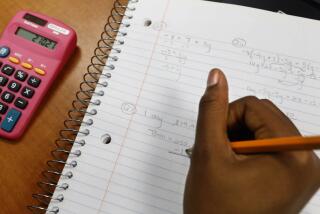When It Comes to Learning Math, Parents Counting on Family Night
Five-year-old Stephanie Orozco peered intently at a glass jar filled with 138 multicolored jellybeans.
For several seconds, the Atwater Elementary School kindergartener stared at the candy. Then, with a look of confidence, she turned to her mother and said, “One hundred.”
“Good,” her mother said, then wrote her daughter’s estimate on a snippet of pink construction paper and dropped it into a plastic basket. Later, Stephanie’s guess would be compared to those from other students who turned in estimates ranging from 40 to 270 jellybeans. A prize would be awarded to the pupil with the most accurate guess.
Colorful Pattern
At a neighboring table, 9-year-old Lauren Vaughn was busily putting brightly painted wooden hexagons, triangles, trapezoids and parallelograms into a colorful pattern. Beaming, the fifth-grader showed her mother and younger brother the completed design.
“That’s really nice. It has kind of an Aztec quality to it,” her mother said.
The Orozcos and Vaughns were among more than 50 parents and children playing games, coloring and making puzzles in Atwater’s multipurpose room. All were participating in this semester’s last session of Family Math, an evening program designed to involve parents in their child’s math education and to improve problem-solving skills through challenging games and activities.
“It brings children and parents together to work on math skills,” said teacher Cheri Engle, who started Family Math at Atwater Elementary in February. Engle said she will offer another round of the program next fall at the ethnically mixed, low- to middle-income school. The six-night course at Atwater was among the first Family Math classes taught in the Los Angeles area, Engle said.
Growing Program
So far, more than 1,800 teachers nationwide have been trained to teach Family Math, including Engle and 60 other Los Angeles teachers who enrolled in a two-day seminar last summer.
Family Math, which augments regular class work, was open to all of Atwater’s 500 students. The only prerequisite was that parents accompany their children. On average, about 85 parents and children attended some or all of the loosely structured sessions.
The free weekly, 1 1/2-hour sessions offered parents and children about 40 activities, including calculator games, graph exercises, bean tosses and an ancient Chinese puzzle game called Tangrams. At the end of each session, parents were offered copies of instructions so they could play the games at home with their children.
“We don’t do a lot of work sheets and writing,” Engle said.
Learning to Estimate
For example, Engle said, when children are asked to guess the number of jellybeans in a jar, they learn how to estimate.
And students who create patterns from colorful geometric shapes develop a sense for “numerical patterning” essential to algebra and geometry, she said.
Family Math is marketed by UC Berkeley’s Lawrence Hall of Science and was developed in 1983 by Virginia Thompson, a San Francisco Bay-area math professor.
“The idea is to involve parents in math education in a positive way,” said Thompson in a telephone interview, “But what do you do to help your kids with math? You can help them with their times tables by making them say them over and over again, and you can get them to do their homework before they go out to play. But what do you do with them that’s fun?
‘Make Them Unafraid’
“It helps kids think about mathematics and communicate with it. If they can’t, they’re going to be in trouble. Our goal is to prepare them and make them unafraid of math.”
“They really enjoy coming here,” Julie Orozco said of her three children, ages 4, 5 and 10. “It also teaches me a lot of things to do with them at home.”
Joan Kinnon, a mother of two elementary school-age children and teacher at a nearby grammar school, said her 6-year-old daughter, Anjali, begged her to attend Family Math.
“She would come home and cry every Thursday night because we couldn’t go to math night, so I changed my schedule,” she said.
‘Lots of Things to Do’
“I wanted to come because there are a lot of things to do,” said Anjali as she chewed a red jellybean that she had used in a counting game earlier that evening. Her favorite activity, she told an observer, is balancing pieces of plastic fruit on a scale--an exercise designed to teach children the units of measuring weight and mass.
“I’m collecting a lot of ideas to use in my own classroom because I know children like math a lot better by doing rather than by reading,” Kinnon said.
Ric Thomas, a Los Angeles County consultant for kindergarten through sixth-grade math programs, said Family Math is gaining popularity locally because it helps teachers introduce parents to the new approach to math education established in California three years ago.
The state guidelines emphasize understanding rather than memorization of concepts and call for greater use of estimation skills, mental arithmetic, calculators, computers and “hands-on” learning.
Luis Gomez, who with his wife, Armida, has attended all six sessions of Atwater Family Math with his two daughters, Armida, 8, and Lupita, 6, said the program has helped his children better understand and enjoy math.
“We’re coming back next year for sure,” he said.
More to Read
Sign up for Essential California
The most important California stories and recommendations in your inbox every morning.
You may occasionally receive promotional content from the Los Angeles Times.










